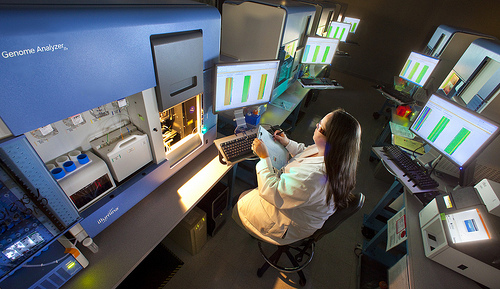Increased funding for science programs at Lawrence Berkeley National Laboratory in recent years has meant more jobs and more research projects. But it has also meant less space. With office and laboratory space becoming increasingly tight and some 20 percent of its staff and facilities already off-site in leased facilities, Berkeley Lab has decided to look off-site for a long-term solution to its space crunch.
In a community presentation Monday evening, Berkeley Lab’s Chief Operations Officer Jim Krupnick spelled out the rationale for opening a second campus to supplement the Lab’s main site in the Berkeley Hills. He also listed desired attributes for a new location and a rough outline of the process for finding a new site and obtaining approval for it in his talk to the Community Advisory Group (CAG).
Berkeley Lab established the CAG, which consists of 15 members from the community, earlier this year to improve communications with neighbors and others on the Lab’s physical planning and development. Meetings are held about once every two months and are open to the general public.

The Department of Energy's Joint Genome Institute, located in Walnut Creek, is one of four Berkeley Lab's off-site facilities and the furthest away.
While most of the 4,200 employees of Berkeley Lab work at its main location in the Berkeley hills, about 20 percent of them are spread around the East Bay in four facilities: the Joint BioEnergy Institute (JBEI) in Emeryville, the Joint Genome Institute (JGI) in Walnut Creek, the National Energy Research Scientific Computing Center in Oakland and much of the Life Sciences Division in West Berkeley.
A single second campus would have substantial scientific benefits by allowing researchers to interact more directly, thus encouraging collaboration and cross-disciplinary research. For example, scientists at JBEI work closely with those in JGI to sequence crops that might be used to produce next-generation biofuels.
But beyond co-locating scattered facilities, a second campus is needed to handle future growth of the Lab—Lab leadership is looking out as far ahead as 30 to 50 years. “We’re still growing,” Krupnick said. “We’re still getting new funding for research programs, such as the Solar Energy Research Center and the User Testbed Facility [for research on energy-efficient buildings].”
To meet these needs, Krupnick said the second site would need to be expandable to 750,000 to 2 million gross square feet. This could eventually double the Lab’s current footprint at its main site, which is about 1.8 million square feet. Another important criterion is that the secondary site be located not more than about 20 minutes away from the main Lab site in Berkeley. Krupnick said the geographic range extends as far north as Richmond and as far south as Alameda. “The only (potential) site we’re sure of is the Richmond Field Station, which is owned by the University of California,” he said.
Other important attributes include affordability, accessibility and proximity to public transportation, good amenities and community support.
Once the size and other requirements are finalized, the Lab plans to issue a Request for Proposals, likely in December. “We’ll see what proposals we get, whittle those down to two to four by the end of winter and make a final selection by the end of next summer,” Krupnick said.
Following environmental review, financing, design and construction, and approvals from the University of California and the Department of Energy, if everything goes as planned, occupancy could begin in 2015, Krupnick said.
Community members expressed strong support for a secondary campus for Berkeley Lab. Some made suggestions, such as making sure it is well integrated with the surrounding community.
Sitting on 200 acres, Berkeley Lab is one of the smallest of the Department of Energy laboratories in the country. By comparison, Oak Ridge National Laboratory in Tennessee sits on 4,470 acres, Brookhaven National Laboratory in New York on 5,320 acres and Pacific Northwest National Laboratory in Washington on 600 acres.
Additional Information